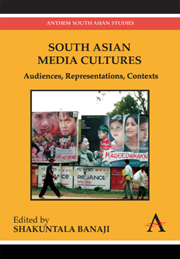Book contents
- Frontmatter
- Contents
- List of Illustrations
- 1 Introduction
- Part One Elaborating Audiences: Meaning, Use and Social Context
- Part Two Telling Texts: Media Discourse, Identity and Politics
- 6 Private Satellite Media and the Geo-Politics of Moderation in Pakistan
- 7 Forgetting to Remember: The Privatisation of the Public, the Economisation of Hindutva, and the Medialisation of Genocide
- 8 Myth – The National Form: Mission Istanbul and Muslim Representation in Hindi Popular Cinema
- 9 A Peace of Soap: Representations of Peace and Conflict in Popular Teledramas in Sri Lanka
- 10 Destigmatising Star Texts – Honour and Shame among Muslim Women in Pakistani Cinema
- Part Three Alternative Producers: The Articulation of (New) Media, Politics and Civic Participation
- List of Contributors
6 - Private Satellite Media and the Geo-Politics of Moderation in Pakistan
from Part Two - Telling Texts: Media Discourse, Identity and Politics
Published online by Cambridge University Press: 05 March 2012
- Frontmatter
- Contents
- List of Illustrations
- 1 Introduction
- Part One Elaborating Audiences: Meaning, Use and Social Context
- Part Two Telling Texts: Media Discourse, Identity and Politics
- 6 Private Satellite Media and the Geo-Politics of Moderation in Pakistan
- 7 Forgetting to Remember: The Privatisation of the Public, the Economisation of Hindutva, and the Medialisation of Genocide
- 8 Myth – The National Form: Mission Istanbul and Muslim Representation in Hindi Popular Cinema
- 9 A Peace of Soap: Representations of Peace and Conflict in Popular Teledramas in Sri Lanka
- 10 Destigmatising Star Texts – Honour and Shame among Muslim Women in Pakistani Cinema
- Part Three Alternative Producers: The Articulation of (New) Media, Politics and Civic Participation
- List of Contributors
Summary
Pakistan's first private satellite television station began transmission at the end of the previous decade. Since 2001, 35 stations have begun broadcasting to and from Pakistan, a relative mania of tertiary sector investment that capitalised on the domestic hunger for news in the wake of the events of 11 September. The American invasion of Afghanistan; the meteoric boom of Pakistan's stock market; the murder of the Wall Street Journal reporter Daniel Pearl; a series of suicide attacks targeting Karachi's areas of international investment and tourism; and, the 2002 general elections which secured the military-presidency of General Pervez Musharraf and unprecedented parliamentary gains for the country's Islamist parties: it is in the lack of any coherent connection between local ‘events’ that their shared relation to a wider and complex conjuncture becomes apparent.
If uncertainty is a governing feature of political and social existence in Pakistan, the craving for official and unofficial news is one of its most apparent symptoms. As such, the growth of private television stations has been a largely news-driven phenomenon, while soundings of praise and disquiet about the effects of this ‘new media’ on the political consciousness of the ‘average Pakistani’ is underscored by the lack of information on the changing opinions and preferences of consumers of this media. Despite the current lack of marketing and audience-based research, the country is awash in 24-hour news cycles, on-the-spot reporting, and a diverse array of talk shows covering politics, health, religious affairs, and the private lives of political and cultural celebrities.
- Type
- Chapter
- Information
- South Asian Media CulturesAudiences, Representations, Contexts, pp. 109 - 122Publisher: Anthem PressPrint publication year: 2010



